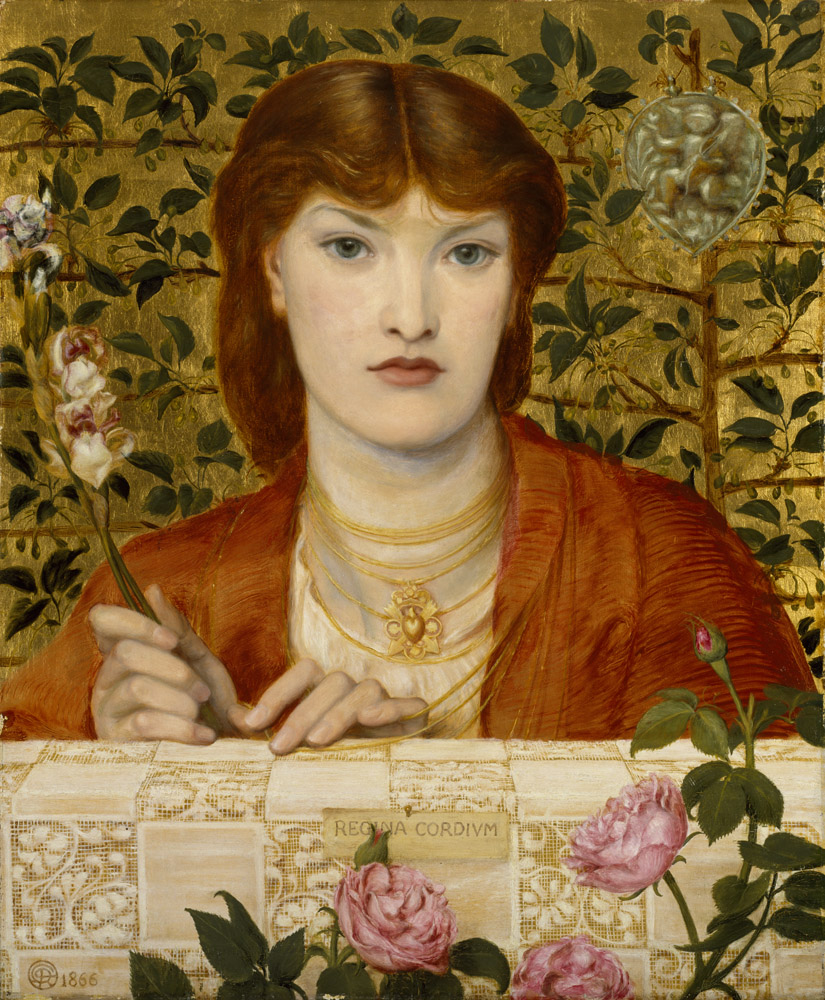Details
- Object type
painting
- Title
Regina Cordium
- Artist/Maker
Dante Gabriel Rossetti artist
- Culture/School
English
- Date
1866
- Materials
oil on canvas on panel
- Dimensions
framed: 928 x 830 x 45 mm; unframed: 597 mm x 495 mm
- Description
-
Dante Gabriel Rossetti’s Regina Cordium was commissioned by John Hamilton Trist of Brighton for £170 and an unknown quantity of champagne. The painting was ‘substantially finished’ by 19 June 1866, although not handed over until August that year. It was purchased for Glasgow Museums by the Trustees of the Hamilton Bequest in 1940, on the advice of the current director of Kelvingrove, Dr T. J. Honeyman, the painting having been left unsold at exhibition in the Beaux Arts Gallery in London. It was bought at a time when the Pre-Raphaelites were little appreciated in Scotland for the meagre sum of £125, the price having been bargained down from 150 guineas. It came with its original gilt and ebony ‘thumb mark pattern’ frame, which Rossetti considered to be an intrinsic part of the picture, and four letters from the artist to Trist.
Painter and poet Rossetti was one of the founder members of the Pre-Raphaelite Brotherhood, a group that formed in London in September 1848. Unlike the other members, Rossetti was less inclined to assiduously copy nature and paint modern moral subjects and was always far more interested in literature, symbolism and the imagination, creating decorative works, inspired by the early Renaissance masters. In 1859 he moved away from painting medieval-inspired watercolours to bust-length oils of beautiful women within enclosed spaces. With the devise of a ledge or parapet separating viewer from figure, these paintings were influenced by the works of the sixteenth-century Venetian masters, particularly the sensuous females of Titian, but also the saints and Madonnas of Giovanni Bellini.
One of the major accusations levelled against Rossetti from the 1860s was that his paintings and poems displayed a gros sensuality. The most famous attack came from Robert Buchanan in his article, ‘The Fleshly School of Poetry’. According to Buchanan, Rossetti’s works were unspiritual, self-conscious and aesthetic with ‘nothing particular to tell us or teach us’. Influenced by French art for art’s sake theories and reacting against the sentimental and moralising nature of much of Victorian painting of the time, Rossetti and other aesthetic painters began experimenting with paintings in which colour, pattern and harmony of form were more important than subject matter. Women were the focal point to emphasise that their subject was beauty alone. To many, Rossetti’s paintings with their mysterious sensual women, richly patterned fabrics, exquisite jewellery and strongly fragranced flowers were self-indulgent and unwholesome. Even more controversially Rossetti used religious iconography in his paintings and poems, subverting the sacred to explore the sacramental nature of physical love.
The Latin title of this painting, ‘Queen of Hearts’, echoes the title given to the Virgin, ‘Regina Caeli’, Queen of Heaven. Rossetti had initially given his model Alexa Wilding a crown but removed it as ‘it seemed to disturb the simplicity of the head’ (letter to Trist). The cherry trellis and rose bushes create a kind of enclosed garden, referencing the walled gardens associated symbolically with the Virgin Mary, although the rose is also emblematic of love. A jewel at her neck shows a flaming heart superimposed on crossed arrows, surmounted by a crown. Hanging from a branch of the fruit tree is a heart-shaped medallion depicting a blindfolded Cupid, the god of love. The purple iris that Wilding holds is suggestive of the Virgin Mary’s ubiquitous lily, denoting her purity. However, looking the viewer directly in the eye, Wilding is no demure Virgin. The striking gold ground enhances the suggestion that this is an object of worship, Beauty elevated to the sacred. As Rossetti’s friend the poet Algernon Charles Swinburne said of an earlier painting Bocca Baciata, it is more
- Credit Line/Donor
Presented by the Trustees of the Hamilton Bequest, 1940
- ID Number
2196
- Location
Kelvingrove Looking at Art
